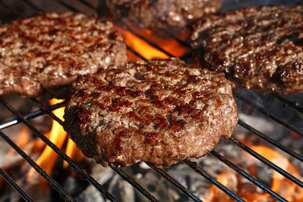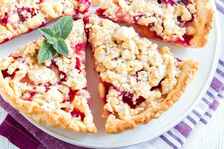Gargling—An American Oral Tradition How you doin’? With all the visiting with friends and family, and the exchange of gifts like colds, flu and other delights, I thought some sage advice might be in order. And while most of my blogs incorporate complete recipes, I thought I'd highlight some of the many individual ingredients that have health and healing properties on their own. For instance, black pepper reduces inflammation and is considered an antibacterial, antioxidant and anti-inflammatory. Garlic has long been associated with health benefits from curing a cold to lowering blood pressure and cholesterol levels. Garlic also contains vitamins C and B6, manganese and selenium but it's a chemical called allicin, a type of antioxidant, which is thought to be responsible for its positive effects on health. It also keeps vampires at bay. Consuming curry powder may boost brain and digestive health, improve feelings of fullness, lower blood sugar levels and provide antibacterial effects. Our ancient civilizations found way to keep health without antibiotics and addictive drugs. Salt (sodium—atomic #11 – symbol Na) is one of the least expensive “chemical” compounds and is plentiful around the globe. One story goes that the earth was hit by a cosmic solid salt meteor billions of years ago that salted our oceans and rained this element down around the globe. Salt has pluses and minuses—too much salt can raise blood pressure and cause some stomach distress but there are many more positive attributes to salt. Salt can draw poisons from open wounds and gargling saltwater can help relieve and prevent infection. It may also help reduce symptoms of other issues affecting the respiratory system such as allergies. Something I remember from my mother and my local dentist, saltwater gargles are a simple, safe, and affordable home remedy. Saltwater gargles are most often used for sore throats, viral respiratory infections like colds, or sinus infections. They may be effective for both relieving infections and preventing them from getting worse, as well. I got my Covid vaccines but still rinsed my mouth out with warm salt water and never got the dreaded virus (study of one). Since it’s also a natural, affordable and convenient remedy, it’s considered a standard go-to home treatment for various ailments. They’ve been used successfully as alternative treatments since before modern medicine. In fact, research and modern medicine still support saltwater gargles today as an effective approach for certain mild health issues. This makes simple saltwater gargles valuable for blocking viruses and bacteria, reducing the chance of infections in the mouth and throat and relieving inflammation in certain cases. These include sore throats, especially effective for colds or flus that cause a mild sore throat. Saltwater gargles can relieve severe sore throats better with the help of acetaminophen (Tylenol) or ibuprofen (Advil). Studies also show that saltwater may help reduce infection severity, whether it’s from a viral or bacterial infection. This includes colds, flus, strep throat and mononucleosis. Since inflammation of the throat can also occur with certain allergies such as pollen or dog and cat dander, saltwater gargles may also help with uncomfortable sore throat symptoms due to these allergic reactions. Saltwater has been shown to draw out water and bacteria while protecting the gums, so saltwater gargles may be effective for improving gum and dental health. They may also help prevent gingivitis, periodontitis, and cavities. Along the same lines as sore throats, saltwater gargles can alleviate canker sores, also known as mouth ulcers. They may do this by easing the pain and inflammation these sores cause. Making a saltwater gargle is quite easy. It requires only two ingredients—water and salt. It takes very little time to make and apply, and it’s completely safe for children over 6 years old to use and for anyone who can gargle easily. The exception would be children under 6 and anyone who has a difficult time gargling. Just mix about 1/4 to 1/2 teaspoon of salt for every 8 ounces of water. The water may be best warm, since warmth can be more relieving to a sore throat than cold. It’s also generally more pleasant. But if you prefer cold water, it shouldn’t interfere with the remedy’s effectiveness. Warm water may also help the salt dissolve into the water more easily. Better dissolving salt might be ideal if you’re using coarse sea salts or kosher salts instead of finer iodized or table salts. You can use any type of salt for saltwater gargles. In case you missed the class Gargling 101, gargle the water in the back of your throat for as long as you can stand. Then, swish the water around your mouth and teeth afterward. Spitting it out into a sink is recommended when you’re finished. However, it can be swallowed if you get off on that sort of thing. In the case of infections, spitting out salt water is considered better at keeping the infection at bay. Be careful if doing multiple mouth rinses per day and swallowing too much salt water, as it can dehydrate you. Drinking too much salt water can also have health risks, such as calcium deficiency and high blood pressure. Gargling at least twice a day is recommended. You can safely gargle many more times than that, too. ChefSecret: If you really hate the taste of salted water, you can improve the taste by adding a little honey and lemon. Quip of the Day: Q. Why did the pony have to gargle? A. Because he was a little horse. ------------------------------------------- Do you have a question or comment? Send your thoughts to [email protected]. All recipes and cooking tips are posted on our website https://www.perspectives-la.com/covid-19-survival-guide. ------------------------------------------- To you and everyone dear to you, be strong, positive, stay well, stay safe and be kind. Take a breath and count your blessings, and if you have a little extra to share with others, please consider donating to Feeding America, Tunnel To Towers, Union Rescue Mission and/or American Red Cross. #SpecialEdition #BenefitsOfSalt #Salt #Saltwater #Gargling #Covid19SurvivalBlog #FeedingAmerica #RedCross #T2T #URM #PerspectivesTheConsultingGroup ©PERSPECTIVES/The Consulting Group, LLC, 2023
0 Comments
The New Rules of Tipping …a Perspective from Ed Engoron How you doin’? For the last 3-1/2 years I’ve been writing this Survival Guide Cooking Lesson series. I’ve tried to keep it fun, informative and pithy, yet not let personal or political opinions poison our work. You can see enough of that junk just by watching any of the 24-hour news outlets. I hope you have benefited from all the hard work it takes to put out the recipes and cooking information. I have been in the food and beverage industry for 40 years and love my career choice. I have owned and operated over 350 restaurants, run our consulting company and Choclatique, our high-end chocolate brand. I was the host on Stump the Chef (10 years) and Joan Vieweger and I co-hosted The Food Show and The Super Foodies on ABC (5-1/2 years). We worked with the founder(s) of McDonalds, Pizza Hut and the CEOs of Disney, Sony, Universal, Target, Walmart and so many others all in the food industry. In fact, you could find our company influence wherever food and people come together… I guess we really are the Super Foodies! After reading an article in a recent issue of New York Magazine I felt compelled to write this editorial. It’s now almost impossible to make any sort of purchase without being confronted with a computer screen asking for 15%, 20%, 25% or 30% gratuity. The other day I was prompted for a 35% gratuity at an airport restaurant on top of the cost of a mediocre $29 burger and fries. It’s not just for a cup of joe at your local Starbucks but buying bottled water at the deli or crackers at a specialty grocery store now also prompts the option for tips. This might irritate or confuse you (it does me), but the reality is there are new post-covid social expectations around what is a tip (versus a service charge), what’s it really worth and who gets it. Here is what’s expected. At restaurants, the previous range of socially acceptable and ethically expected tips was 15% to 20%; now, it’s 20% to 25% or higher. That’s when the minimum wage was truly minimum. A lot of these jobs we never created to feed a family of four or more. This goes for whether you’re at a Ruth’s Chris Steak House, Olive Garden or Cracker Barrel and whether you felt the service was deserving or not (T.I. P.S. = To Insure Proper Service, an old English tavern tradition—blame the Brits). These days, the expectation--demand—is that the higher your disposable income, the more you should tip, but anything under 20% is just rude—Pay Your Fair Share! Blame this on inflation, COVID, and the heightened awareness that more than half of your servers’ salary probably comes from tips. You are told it’s just the rules. So, just pay, don’t complain—STFU. At coffee shops, coffee carts, cafés and bodegas, tip at least 20 % even though their pay isn’t as tip dependent for servers as it used to be. The average salary for a barista in New York is just above minimum wage (at Starbuck’s that’s plus profit sharing and a 401K). Baristas are often preparing complicated orders in a tense environment—I want my caffeine now! If your order is only regular coffee, you may tip $1. If you’re buying an item that involves no preparation (a bottle of water, a muffin), it is acceptable, though considered miserly, not to tip. For food delivery, you are expected to tip a minimum of $5, or 20%, whichever is greater, and even more in bad weather according to the “new” rules of wokeness. Because delivery workers are categorized as independent contractors, their employers don’t have to pay them minimum wage. And per a recent survey from the Worker’s Justice Project and the Worker Institute at Cornell, the median hourly wage for an app delivery worker in New York is only $10.94 an hour, or $15.21 with tips. Also, given the history of tips not always making it into the delivery person’s hands, you are expected to tip with cash whenever possible. If you don’t, you may get on the area’s no delivery list. When picking up takeout at a restaurant, it’s easy to understand why you might not tip anything, however you are now expected to tip at least 10 %. The stated reason… a takeout order interrupts the flow of the other work required of servers and hosts who are dependent on tips. BS! Develop a better and fairer compensation plan for your employees and do not tack anything more on inflation-poor customers. At a bar, the conventional wisdom was to tip at least $1 per drink if you’re just getting a beer and 20% for a cocktail. If you’re at a food counter—a cheese shop, a deli counter, or a fast-casual lunch spot where employees are telling you about the items, slicing or mixing you a food bowl—you are now expected to tip something if prompted. Ideally 10 %. At a deli, for instance, the tip pool is divided among the employees who are paid hourly, which means that instead of making minimum wage ($16 an hour), they now take home around $21 an hour. How are you expected to tip Uber drivers? The same way you’d tip a cabdriver—at least 20%. The Uber app can make adding a tip feel like more of an afterthought, but it shouldn’t be. According to new data from the Taxi & Limousine Commission, Uber drivers earn substantially less in fares and tips than taxi drivers (plus the company—Uber—takes more than a 25% cut of fares and deliveries). For everything else—hairstylists, waxers, movers (yes, movers)—you are expected to tip 20% minimum. And, maybe more if you can. Do not be intimidated by having a screen thrust in your face with a demand for a gratuity in the amount of 20% to 35%. My philosophy is to tip what you can afford for the value of the service. Quip of the Day: Q. Why should you tip the guy at the crematorium? A. Because he urned it! ------------------------------------------- Do you have a question or comment? Send your thoughts to [email protected]. All recipes and cooking tips are posted on our website https://www.perspectives-la.com/covid-19-survival-guide. ------------------------------------------- To you and everyone dear to you, be strong, be positive, stay well, stay safe and be kind. Take a breath and count your blessings, and if you have a little extra to share with others, please consider donating to Feeding America and/or American Red Cross. #TippingRules #2023Recipes #Covid19 #FeedingAmerica #RedCross #PerspectivesTheConsultingGroup ©PERSPECTIVES/The Consulting Group, LLC, 2023 …from the Perspectives’ Kitchen How you doin’? Are you getting your barbecue cleaned-up for summer cookouts? It’s that time of year to scrape down the grill and dust off the tongs and spatula so you can make those perfect backyard burgers. Here’s a hack that will make your burgers juicy and flavorful every single time. The best part is that it costs you nothing and you can find it in just about any kitchen—regular ice cubes. You simply make your patties as you normally would, then put a single ice cube in the center of each one and fold the meat around it. When you grill the patty, the melting cube keeps the patty from drying out by distributing more moisture throughout the patty. The best thing about using an ice cube is that it’s only plain water and it won't impact the flavor of the seasonings you use in the patty. It's also readily available. Just place your patties on the grill and then put an ice cube in the center of each patty, pressing it down gently. Then, you just cook the patties like you normally would. It’s best to cook the burgers to at least medium rare if you plan to use an ice cube to keep the patty juicy and safely enjoy your upgraded hamburger. A medium rare burger is a burger that has been cooked to an internal temperature of around 145⁰ F). This means that the center of the patty is still pink and slightly warm, with a crust on the outside that is browned or seared. When cooking a medium rare burger, it should be grilled for about three to four minutes per side, depending on the thickness of the patty and the heat of the grill. You can use a meat thermometer to check the internal temperature of the patty to ensure it has reached 145⁰ F. It is important to remember that consuming undercooked or raw meat, including beef, can lead to food poisoning according to the USDA. Therefore, it is important to cook the burgers until they reach the appropriate internal temperature. To mitigate this risk, many people like to eat their burgers well done. A well-done burger is cooked to an internal temperature of around 160-165 ⁰ F. The patty will be cooked through and through, with no pink or red remaining in the center. The meat is also typically dryer than a medium-rare or medium burger, which is why using an ice cube can really help. It keeps well-done patties a little moister. When cooking a well-done burger, it should be grilled for longer than a medium-rare or medium burger, usually around five to seven minutes per side, once again depending on the thickness of the patty and the heat of the grill. Once the burgers are cooked to your liking, remove them from the grill and let them rest for a few minutes before serving. This allows the juices to settle and redistribute throughout the patty. The-ice-cube-hack-for-ridiculously-juicy-burgers-every-time helps the hamburger retain its moisture and juices when grilling so that the high heat of the grill won’t zap all the natural juices out you your best grilled hamburgers. Grill on! ChefSecret: If you like a really juicy burger, be sure to buy hamburger meat that is at least 20% fat (80%/20%). Leaner hamburger dries out easier. Quip of the Day: How did the French fry propose to the hamburger? Answer: He gave her an onion ring! -------------------------------------------------- Do you have a question or comment? Send your thoughts to [email protected]. All recipes and cooking tips are posted on our website https://www.perspectives-la.com/covid-19-survival-guide. ------------------------------------------- To you and everyone dear to you, be strong, be positive, stay well, stay safe and be kind. Take a breath and count your blessings, and if you have a little extra to share with others, please consider donating to Feeding America and/or American Red Cross. #Entrees #Grill #Burgers #IceCubeHack #2023 #QuarantineKitchen #Covid19 #FeedingAmerica #RedCross #PerspectivesTheConsultingGroup ©PERSPECTIVES/The Consulting Group, LLC, 2023 CHOCOLATE CHIP, OATMEAL & YOGURT MORNING CEREAL SUNDAES…from the Perspectives’ Kitchen  How you doin’? Are you feeling sluggish, bloated and uncomfortable? Maybe you’re just full of s—t! No, really the causes of constipation are varied and can be the foods you eat or the types of foods you don’t eat. It might be one or more of the medications you take. If you are having bowel movement problems you might want to add some of the foods listed below to your diet to help you poop. You may be surprised to learn that this dreaded personal problem affects 16 out of 100 adults who deal with the symptoms of constipation regularly. This number doubles as you get older. For adults ages 60 and over, constipation is a common symptom in 33 out of 100 adults according to the National Institutes of Health. What can you do? What should you eat? Fiber is part of the solution. The first step is to increase your daily fiber intake. Most whole foods that naturally contain fiber are great choices. These foods also contain vitamins, minerals and numerous other nutrients that are beneficial to the body. According to the current Dietary Guidelines for Americans, the average daily intake of dietary fiber for adults should be 22 grams to 34 grams. Men, on average, require more dietary fiber than women, or between 31 and 34 grams. Most Americans, however, do not get the necessary amount, just averaging just 10 to 15 grams of fiber a day. That’s just not good enough. You need both soluble and insoluble fiber for healthy digestion. Insoluble fiber is found in foods such as whole grains and vegetables, whereas soluble fiber is found in oat bran, nuts, seeds, beans, lentils and some fruits and veggies. If your diet was previously not high in fiber, slowly incorporate fiber-rich foods so your digestive tract can get better acclimated to dietary change and avoid gastrointestinal distress or gas. Here are some of the foods that are worth adding to your daily meal plans to help stimulate digestion and keep you regular. 1. Water One of the critical fluids required by the body. Water accounts for more than two-thirds of your body's weight and plays an essential role in regular body functions. From keeping you hydrated and lubricating joints to regulating body temperature and ridding the body of waste, water is necessary for the human body to survive. It's especially important in helping relieve constipation and keeping you regular. Your daily water intake depends on several factors including age, activity level, and gender. A good standard to help prevent constipation is about 15-1/2 cups daily for men and 11-1/2 cups daily for women. It can go up from here depending on the amount of time you're exercising or if you’re sweating a lot. A good thing to remember, poop is made up mostly of water! 2. Flax Seeds A rich source of polyunsaturated fats, omega-3 fatty acid and soluble fibers, flax seeds are tiny but mighty seeds that provide numerous health benefits, including relief from constipation. A tablespoon of ground flax seeds contains eight percent of the Daily Value (DV) of dietary fiber. It's also a source of iron, potassium, and magnesium, as well as B-vitamins and carotenoids like lutein. For flaxseeds to be beneficial to your body and bowel movements, ground flax seeds are much better at providing nutrients than whole ones, which often pass undigested through the digestive tract. 3. Oatmeal When it comes to your bowels, there's no better way to start the day than with a cup of oatmeal, which contains four grams or 16 percent of the Daily Value of dietary fiber. Oatmeal is a bonus food that contains both soluble and insoluble fiber which helps bulk up the weight and size of your stool, making it easier to pass. Studies have shown that soluble fibers may lower levels of the "bad" LDL cholesterol in the bloodstream and help reduce the risk of heart disease. And that's not all. Oats are a surprisingly great source of protein, offering 5.9 grams or 12 percent of the Daily Value of protein and contain high amounts of iron, magnesium, and zinc. 4. Pears Rich in minerals, specifically potassium and magnesium, which are necessary for muscle contraction and cellular signaling, fresh pears are also a great source of dietary fiber. A single, medium-sized pear offers as much as six grams of fiber. Pears are best consumed with their skins, as they contain several flavonoids that reduce blood glucose levels and the incidence of cardiovascular disease. They are also high in pectin, a soluble fiber that offers prebiotic properties to the human gut. So, no matter the variety, whether it's Anjou, Bartlett or Bosc, adding pears to your diet can help get things moving again. 5. Coffee Known for being a good source of antioxidants such as chlorogenic acid, a cup of caffeine-rich coffee not only helps fight inflammation and reduces the risk of cardiovascular and liver diseases, but it also helps you with your bowel movements—about 30 percent of people find relief when drinking coffee. It gets things moving, and some people even claim this effect from decaf. If you're suffering from irregular poops, brewing yourself a fresh cup of joe just might be the solution for you. However, moderation is key. A study found that while modest caffeine consumption resulted in a decrease in constipation and incidence of colorectal cancer, frequent use had the opposite effect. This is likely related to the dehydrating effects of a high-caffeine diet. 6. Nuts Go nuts! Almonds, pecans and peanuts are all excellent sources of soluble fiber, which the National Institute of Diabetes and Digestive and Kidney Diseases recommends eating for children that are dealing with constipation. Adults can benefit from this recommendation, too, as a 200-calorie serving of pecans offers 11 percent of the Daily Value of dietary fiber, as well as five percent of the Daily Value of protein and a lot of minerals and vitamins. In addition to keeping you regular, adding nuts to your diet may help lower the incidence of type 2 diabetes, prevent weight gain, and increase your overall lifespan. They're also a great source of antioxidants like tocopherols, which may reduce the risk of certain cancers. Best of all, nuts are delicious. 7. Legumes From a vegetarian pantry staple to a budget-friendly meal option, the versatility of legumes knows no bounds. Comprised of beans, peanuts, lentils and peas, legumes are not only beneficial for their fiber and protein content but are also low in fat and have a low glycemic index, making them a suitable dietary addition for patients with diabetes. And, when it comes to helping you poop regularly, beans are what's best. Beans are another food that contains that winning combination of soluble and insoluble fiber. These fibers are great for feeding gut bacteria, stimulating digestion and soaking up water as it moves through the body, helping to bulk up your stool and prevent constipation. 8. Prunes Prunes or dry plums provide approximately seven grams of dietary fiber per 100-gram serving. They're also rich in minerals like magnesium, as well as vitamins A, E, and K, which help in everything from muscle contraction and blood clotting to boosting immunity and vision. Researchers published in Clinical Nutrition found that prunes help maintain healthy bowel functions, especially for people with low-fiber diets and infrequent stool habits. Prune juice makes an especially good choice for pregnant women suffering from constipation who may not have much of an appetite. Sorbitol, which is a sugar alcohol typically found in diabetes-friendly sweeteners, naturally occurs in prunes, which is also a stimulate to your bowels. Prunes help to stimulate digestion by helping to move water into the large intestine." 9. Whole Grains Switching from refined grains like white rice to whole ones, such as brown rice, is one of the best ways to help you poop more frequently. The United States Department of Agriculture explains that adding whole grains to your diet can help prevent the occurrence of certain chronic diseases like obesity, heart disease, and type 2 diabetes. Whole grains like whole-wheat pasta, barley and whole-grain breads are not only high in dietary fiber but are also a good source of B vitamins such as thiamin, riboflavin, niacin, and folate, as well as minerals like selenium and iron that help develop the body's immune system and muscles. 10. Fermented Beverages Foods naturally rich in probiotics, such as kombucha and kefir, host helpful bacteria that help improve gut health and the process of digestion, making it easier to pass stools. Kefir, a fermented milk beverage, contains both bacterial and fungal species and helps restore the balance of bacterial cultures in the digestive tract. Not eating enough fiber and not drinking enough water are some of the most common causes of constipation. Taking certain medications (such as Prozac or opioids) and even antibiotics can lead to problems in digestion. Recent studies have shown that probiotics such as kefir can help soften stools, making them easier to pass. Starting your day with Morning Cereal Sundaes makes Jack and Jill a regular guy and gal. Chocolate Chip, Oatmeal & Yogurt Morning Cereal Sundaes Prep Time: 5 minutes Chill Time: 8 hours (overnight) Yield: 1 serving Ingredients 1 container (5.3 oz.) Greek yogurt, any flavor 1/4 cup old-fashioned or quick-cooking oats 1 teaspoon chia seeds 2 tablespoons dark chocolate chips Stir-ins (see ideas below) Directions
ChefSecret: Add any desired stir-ins like fresh berries, toasted or raw nuts (almonds are best), bananas, mango, papaya, orange segments, preserved lemon, pomegranate, etc. Quip of the Day: Poop jokes aren't my favorite jokes. But they're a solid #2. ------------------------------------------- Do you have a question or comment? Do you want to share a with our readers? Send your favorite recipes, pictures or thoughts to [email protected]. Recipes and cooking tips are posted on our website https://www.perspectives-la.com/covid-19-survival-guide. To you and everyone dear to you, be strong, be positive, stay well, stay safe and be kind. Take a breath and count your blessings, and if you have a little extra to share with others, please consider donating to Feeding America and/or American Red Cross. #Breakfast #Oatmeal #Cereal #Yogurt #Constipation #Fiber #FoodsThatRelieveConstipation #Prunes #Coffee #WholeGrains #2023Recipes #QuarantineKitchen #Covid19 #FeedingAmerica #RedCross #PerspectivesTheConsultingGroup ©PERSPECTIVES/The Consulting Group, LLC, 2023 Cooking Lesson #593: Stop! Don’t Eat That, It Can Kill You Plus, Strawberry-Rhubarb Pie Recipe3/22/2023 …from the Perspectives’ Kitchen  How you doin’? There’s a Strawberry-Rhubarb Pie in your future. But first… some important information. The people at Allrecipes always come up with very useful information. Here is something you should read carefully and abide by the warnings. When we were kids, we were often warned not to eat certain things because "they're poisonous." Ever wondered if those warnings had any basis in fact, or if they were nothing but a combination of hand-me-down myths and an easy way for parents to scare the food out of children’s mouths? As it turns out, most of the things we were told were true. Though most will not cause death, they will often produce enough gastrointestinal distress that you might wish you were dead. Take heed—here are some of the most commonly cautioned food items that are, in fact, toxic to one degree or another. Rhubarb Leaves When I was growing one of the major harbingers of spring was the appearance of rhubarb in the produce section of my local store. It just looked like harmless red celery to me, but I knew that a strawberry-rhubarb pie was soon to appear at my local Marie Calendar’s Pie Store. We were always forbidden from touching the rhubarb ourselves as the leaves were supposedly poisonous… absolutely true. The rhubarb stalks are edible and perfectly safe for a berry pie, but rhubarb leaves are not something you want to consume. They contain a notable concentration of oxalic acid—which can not only produce very unpleasant gastro symptoms, but it also prevents the absorption of calcium, a nutrient we all need. Oxalic acid, though a natural compound found in a number of plants, is the active ingredient in the cleaning product Bar Keepers Friend, if that tells you anything. Having said that, you'd need to eat quite a few rhubarb leaves to do any major harm, but it really is safer just to avoid them altogether. It's also a good idea to make sure your pets do not have access to rhubarb plants. Cherry Pits Cherry Pits contain cyanide, and cyanide, is not anything you want to ingest. The good news is that the pit must be cracked open to be really dangerous, so if you were to accidentally swallow a whole one, you should be okay. But I'd still advise you to avoid swallowing one, and if you do find yourself in that position, play it safe and call your doctor. Apple Seeds Yes, Apple Seeds are on the "things you should not eat list." Once again, cyanide is the culprit here. But as with cherry pits, swallowing a few whole apple seeds should not cause any health problems. Seriously though, just don't make a habit of ingesting these nasty little back seeds. Uncooked Kidney Beans Now, it's hard to imagine a scenario where you would eat a dried, unsoaked, uncooked kidney bean, but still...don't. Kidney Beans contain a large amount of lectins. Similar to oxalic acid, lectins are often referred to as an "antinutrient." And lectins will produce a whole host of highly unpleasant gastrointestinal symptoms. It only takes a few to cause these symptoms, so soak your Kidney Beans and fully cook them before enjoying. It is also best not to use uncooked Kidney Beans in a slow cooker. Elderberries Don't panic… ripe, cooked Elderberries are just fine and add great healthy benefits to your diet. But the unripe berries, the leaves, and the bark contain both cyanide and lectins. The consequences of consuming any of the above are not good. If you have an Elderberry tree in your backyard, be warned not to eat the tempting little fruit directly from the tree. Nutmeg I always assumed eating Nutmeg was an urban myth where eating (or smoking) it could get you "high." I never tried that. My nutmeg consumption is basically limited to Christmastime. Turns out, it is possible, but you'd have to eat a whole lot of Nutmeg. Long before you felt that kind of effect, you would be very ill. There is an oil in Nutmeg, called myristicin, that's to blame. That said, a dusting on your eggnog, or a bit in your baked goods, is just fine. Potatoes (Don’t panic, read on) Sometimes older Potatoes or ones that have been exposed to too much light, will start to turn green. Glycoalkaloids (solanine) are the "bad guys" in this scenario, and they will yield incredibly unpleasant physical effects if consumed. If a Potato has the barest hint of green, and it's otherwise firm, unsprouted, unwrinkled, and smells like a potato, and if a pass or two with the vegetable peeler clearly removes any trace of green you can go ahead and use them. However, you should never, ever eat green Potato flesh, nor sprouts on a Potato, nor the area around the sprouts. Mangoes Don't worry, I am not going to tell you to forgo eating mangoes, one of the world's great pleasures. However, do be aware, they contain urushiol. The other common plant filled with urushiol is poison ivy. However, eating the delicious flesh of a mango is no problem; just avoid eating the skin, bark, and leaves. And for most people, managing the unpeeled fruit is not a problem while you peel it. Poinsettias While not a food, many of us love to fill our homes with these beautiful bright red plants each December. Someone on the news will inevitably warn us that death is around the corner if we eat a leaf. Now, while it is true that ingesting a few leaves will give you an upset stomach, and that contact with the plant's milky sap can cause an itchy rash, the Poinsettia is not a murderer in Santa's clothing. Should you eat them? No. Should you try to avoid the sap if you break off a stem or a leaf? Yes. But if you happen to "mess up" on either front, I believe that you'll live through December. So feel free to decorate with abandon as long as you are careful about keeping the poinsettias out of reach for children or pets. All of the above facts are certainly not intended to frighten anyone but having reliable information is never a bad thing, and I believe that these bits of information are worth knowing. If you know that you are severely allergic or susceptible to the dangerous compounds in any of these foods, you should completely avoid them. ChefSecret: Here’s my recipe for a perfect Strawberry-Rhubarb Pie with Crumb Topping Prep time: 20 minutes Bake time: 1 hour Yield: 8 servings Ingredients For the pie crust 1 single pie crust your favorite pre-made recipe or store-bought Egg wash for brushing on the pie edges 1 yolk + 1 tablespoon water For the crumb topping 1-1/4 cups all-purpose flour 1/2 cup granulated sugar 1/4 teaspoon nutmeg 1/2 teaspoon apple cider vinegar 1/8 teaspoon kosher salt 1/2 cup unsalted melted butter (1 stick) For the pie filling 3 cups strawberries washed and sliced into large pieces 3 cups rhubarb washed and sliced into ½-inch slices 1 teaspoon lemon zest 2 teaspoons freshly-squeezed lemon juice 3/4 cup granulated sugar granulated 1/2 teaspoon cinnamon 1/4 teaspoon nutmeg 4 tablespoons cornstarch 1/8 teaspoon kosher salt Directions Baking the pie crust
Quip of the Day: “I usually cut my pie into four pieces. I don’t think I could eat all eight.” ------------------------------------------- Do you have a question or comment? Send your thoughts to [email protected]. All recipes and cooking tips are posted on our website https://www.perspectives-la.com/covid-19-survival-guide. ------------------------------------------- To you and everyone dear to you, be strong, be positive, stay well, stay safe and be kind. Take a breath and count your blessings, and if you have a little extra to share with others, please consider donating to Feeding America and/or American Red Cross. #Baking #Strawberry-RhubarbPie #ToxicFoods #Dessert #2023Recipes #QuarantineKitchen #Covid19 #FeedingAmerica #RedCross #PerspectivesTheConsultingGroup ©PERSPECTIVES/The Consulting Group, LLC, 2023 |
For over 4 decades collaboration and vision have been the cornerstones of our approach to developing innovative solutions. We fuel innovation, uncover opportunities, discover trends and embrace sustainability, turning imaginative ideas into profitable realities. Categories
All
Archives
July 2024
|
www.perspectives-la.com
Copyright © 2021 Perspectives/The Consulting Group, LLC | Henderson, NV 89052 | 310-477-8877
Copyright © 2021 Perspectives/The Consulting Group, LLC | Henderson, NV 89052 | 310-477-8877


 RSS Feed
RSS Feed